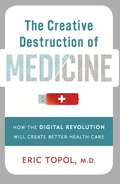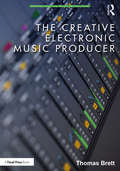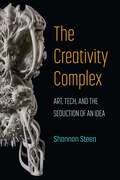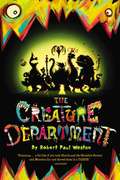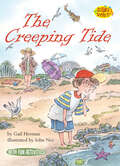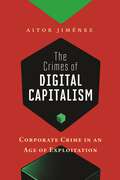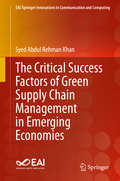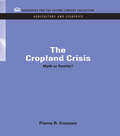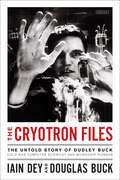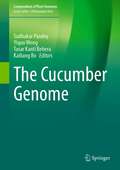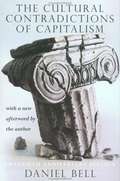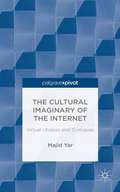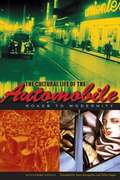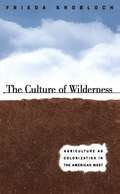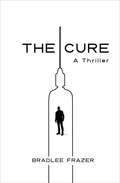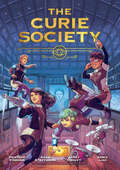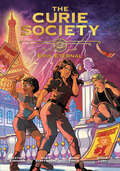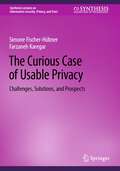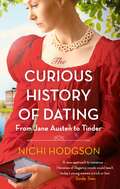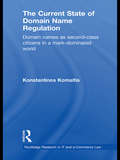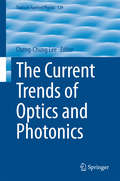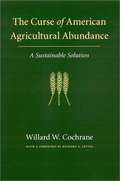- Table View
- List View
The Creative Destruction of Medicine: How the Digital Revolution Will Create Better Health Care
by Eric TopolWhat if your cell phone could detect cancer cells circulating in your blood or warn you of an imminent heart attack? Mobile wireless digital devices, including smartphones and tablets with seemingly limitless functionality, have brought about radical changes in our lives, providing hyper-connectivity to social networks and cloud computing. But the digital world has hardly pierced the medical cocoon. Until now. Beyond reading email and surfing the Web, we will soon be checking our vital signs on our phone. We can already continuously monitor our heart rhythm, blood glucose levels, and brain waves while we sleep. Miniature ultrasound imaging devices are replacing the icon of medicine--the stethoscope. DNA sequencing, Facebook, and the Watson supercomputer have already saved lives. For the first time we can capture all the relevant data from each individual to enable precision therapy, prevent major side effects of medications, and ultimately to prevent many diseases from ever occurring. And yet many of these digital medical innovations lie unused because of the medical community's profound resistance to change. In The Creative Destruction of Medicine, Eric Topol--one of the nation's top physicians and a leading voice on the digital revolution in medicine--argues that radical innovation and a true democratization of medical care are within reach, but only if we consumers demand it. We can force medicine to undergo its biggest shakeup in history. This book shows us the stakes--and how to win them.
The Creative Electronic Music Producer (Perspectives on Music Production)
by Thomas BrettThe Creative Electronic Music Producer examines the creative processes of electronic music production, from idea discovery and perception to the power of improvising, editing, effects processing,sound design. Featuring case studies from across the globe on musical systems and workflows used in the production process, this book highlights how to pursue creative breakthroughs through exploration, trial and error tinkering, recombination, and transformation.The Creative Electronic Music Producer maps production's enchanting pathways in a way that will fascinate and inspire students of electronic music production, professionals already working in the industry, and hobbyists.
The Creativity Complex: Art, Tech, and the Seduction of an Idea
by Shannon Steen“Creativity” is a word that excites and dazzles us. It promises brilliance and achievement, a shield against conformity, a channel for innovation across the arts, sciences, technology, and education, and a mechanism for economic revival and personal success. But it has not always evoked these ideas. The Creativity Complex traces the history of how creativity has come to mean the things it now does, and explores the ethical implications of how we use this term today for both the arts and for the social world more broadly. Richly researched, the book explores how creativity has been invoked in arenas as varied as Enlightenment debates over the nature of cognition, Victorian-era intelligence research, the Cold War technology race, contemporary K-12 education, and even modern electoral politics. Ultimately, The Creativity Complex asks how our ideas about creativity are bound up with those of self-fulfillment, responsibility, and the individual, and how these might seduce us into joining a worldview and even a set of social imperatives that we might otherwise find troubling.
The Creature Department
by Robert Paul Weston Framestore"Stunning...a bit like if you took Charlie and the Chocolate Factory and Monsters Inc. and shoved them in a TARDIS." --Buzzfeed It's a tentacled, inventive, gooey, world in there. . . . Elliot Von Doppler and his friend Leslie think nothing ever happens in Bickleburgh, except inside the gleaming headquarters of DENKi-3000--the world's eighth-largest electronics factory. Beneath the glass towers and glittering skywalks, there's a rambling old mansion from which all the company's amazing inventions spring forth. And no one except Uncle Archie knows what's behind the second-to-last door at the end of the hall. Until Elliot and Leslie are invited to take a glimpse inside. They find stooped, troll-like creatures with jutting jaws and broken teeth. Tiny winged things that sparkle as they fly. And huge, hulking, hairy nonhumans (with horns). It is unlike anything they've ever seen. But when Chuck Brickweather threatens to shut down the DENKi-3000 factory if a new product isn't presented soon, the creatures know they are in danger. And when Uncle Archie vanishes, it's up to Elliot, Leslie, and every one of the unusual, er, "employees" to create an invention so astonishing it will save the Creature Department.
The Creeping Tide (Science Solves It!)
by Gail HermanSolve kid-sized dilemmas and mysteries with the Science Solves It! series. These fun books for kids ages 5–8 blend clever stories with real-life science. Why did the dog turn green? Can you control a hiccup? Is that a UFO? Find the answers to these questions and more as kid characters dive into physical, life, and earth sciences. Missing sunglasses? Stolen sunscreen? And the beach blanket is sandy and wet! Can Jack solve the mystery and find out what is going on? Books in this perfect STEM series will help kids think like scientists and get ahead in the classroom. Activities and experiments are included in every book! (Level One; Science topic: Tides)
The Crime of Reason: And the Closing of the Scientific Mind
by Laughlin Robert B.We all agree that the free flow of ideas is essential to creativity. And we like to believe that in our modern, technological world, information is more freely available and flows faster than ever before. But according to Nobel Laureate Robert Laughlin, acquiring information is becoming a danger or even a crime. Increasingly, the really valuable information is private property or a state secret, with the result that it is now easy for a flash of insight, entirely innocently, to infringe a patent or threaten national security. The public pays little attention because this vital information is "technical”--but, Laughlin argues, information is often labeled technical so it can be sequestered, not sequestered because it’s technical. The increasing restrictions on information in such fields as cryptography, biotechnology, and computer software design are creating a new Dark Age: a time characterized not by light and truth but by disinformation and ignorance. Thus we find ourselves dealing more and more with the Crime of Reason, the antisocial and sometimes outright illegal nature of certain intellectual activities. The Crime of Reason is a reader-friendly jeremiad, On Bullshit for the Slashdot and Creative Commons crowd: a short, fiercely argued essay on a problem of increasing concern to people at the frontiers of new ideas.
The Crimes of Digital Capitalism: Corporate Crime in an Age of Exploitation (Justice, Inequality, and the Digital World)
by Aitor JiménezHow technology companies profit from our increasing dependence on digital infrastructure and the privatization of dataThe Crimes of Digital Capitalism proposes the first comprehensive theory of corporate crime for the digital age. Aitor Jiménez explores the criminal structure of digital capitalism fostered by states and corporations along the supply chain, illustrating how the rise of algorithmic racism, the Googlization of education, and the deployment of AI surveillance/killing technologies brutally impacts the lives of millions of people around the world.Under the label of digital capitalism, argues Jiménez, lives a system of exploitation that, standing on digital technologies, is pushing the neoliberal project into an entirely new dimension of practices and exploitative policies with its own set of socially harmful consequences. Digital capitalism has accelerated the neoliberal attack on labor rights, expanded previous forms of exploitation, and developed new ways of surveilling and controlling workers. Delving into the structural relation between capitalism and corporate crime in the digital age, The Crimes of Digital Capitalism argues that the massive social harms caused by large technology companies and states should not be seen as accidental by-products, but as criminal strategies necessary for the existence of digital capitalism.Linking the debates on the platform economy to today’s most pressing social justice issues, this deeply interdisciplinary book connects complex ideas around digital capitalism to everyday problems.
The Critical Success Factors of Green Supply Chain Management in Emerging Economies (EAI/Springer Innovations in Communication and Computing)
by Syed Abdul KhanThis book outlines the scope of sustainability and green practice in supply chain operations, which has continued to grow with a rapid speed. The book includes core aspects of sustainability and green supply chain management philosophy and practice, covering general concepts, principles, strategies and best practices, which not only protect socio-environmental sustainability, but spur economic growth. The book will aid practitioners in using sustainable supply chains to reduce cost and improve service, as well as keep up-to-date with different features of green supply chains and logistics in a global market. The book will also be a valuable resource for candidates undertaking certification examinations and students studying for degrees in related fields of sustainability and green supply chain management.
The Cropland Crisis: Myth or Reality? (RFF Agriculture and Fisheries Set)
by Pierre CrossonThis book examines the factors affecting the demand for agricultural land in the United States and the costs of meeting increasing demand. Originally published in 1982
The Cryotron Files: The Untold Story Of Dudley Buck, Pioneer Computer Scientist And Cold War Government Agent
by Iain Dey Douglas BuckThe riveting true story of Dudley Buck, the American computer scientist whose pioneering work with microchips placed him firmly in the sights of the KGB Dr. Dudley Allen Buck was a brilliant young scientist on the cusp of fame and fortune when he died suddenly on May 21, 1959, at the age of 32. He was the star professor at MIT and had done stints with the NSA and Lockheed. His latest invention, the Cryotron—an early form of the microchip—was attracting attention all over the globe. It was thought that the Cryotron could guide a new generation of intercontinental ballistic missiles to their targets. Four weeks before Dudley Buck’s death, he was visited by a group of the Soviet Union’s top computer experts. On the same day that he died from a mysterious sudden bout of pneumonia, his close colleague, Dr. Louis Ridenour, was also found dead from similar causes. Two top American computer scientists had unexpectedly died young on the same day. Were their deaths linked? Two years old when his father died, Douglas Buck was never satisfied with the explanation of his father’s death and has spent more than 20 years investigating it, acquiring his father’s lab books, diaries, correspondence, research papers and patent filings. Armed with this research, award-winning journalist Iain Dey tells, with compelling immediacy, the story of Dudley Buck’s life and groundbreaking work, starting from his unconventional beginnings in California through to his untimely death and beyond. The Cryotron Files is at once the gripping narrative history of America and its computer scientists during the Cold War and the dramatic personal story of rising MIT star Dudley Buck in the high-stakes days of spies, supercomputers, and the space and nuclear race.
The Cucumber Genome (Compendium of Plant Genomes)
by Tusar Kanti Behera Sudhakar Pandey Yiqun Weng Kailiang BoThis edited book presents the latest research on cucumber, its genetic resources and diversity, tissue culture and genetic transformation, mapping of economic genes and QTLs, whole genome sequencing, comparative genomics, and breeding strategies. The mechanism of sex expression, interspecific hybridization, and cell biology are also described. The book discusses the genome draft of cucumber and the application of genome editing. This book is useful to the students, teachers and scientists in academia and relevant private companies interested in horticulture, genetics, breeding, and related areas.
The Cultural Contradictions of Capitalism (20th Anniversary Edition)
by Daniel BellThis classic analysis of Western liberal capitalist society contends that capitalism and the culture it creates harbors the seeds of its own downfall by creating a need among successful people for personal gratification a need that corrodes the work ethic that led to their success in the first place.
The Cultural Imaginary of the Internet: Virtual Utopias and Dystopias
by Majid YarContemporary culture offer contradictory views of the internet and new media technologies, painting them in extremes of optimistic enthusiasm and pessimistic concern. This book explores such representations, uncovering the roots of our cultural responses to the internet, centred upon a profoundly ambivalent reaction to technological modernity.
The Cultural life of the Automobile: Roads to Modernity
by Guillermo GiucciFrom its invention in Europe at the end of the nineteenth century, the automobile crisscrossed the world, completely took over the cities, and became a feature of daily life. Considered basic to the American lifestyle, the car reflected individualism, pragmatism, comfort, and above all modernity. In Latin America, it served as a symbol of distinction, similar to jewelry or fine clothing. In The Cultural Life of the Automobile, Guillermo Giucci focuses on the automobile as an instrument of social change through its "kinetic modernity" and as an embodiment of the tremendous social impact of technology on cultural life. Material culture-how certain objects generate a wide array of cultural responses-has been the focus of much scholarly discussion in recent years. The automobile wrought major changes and inspired images in language, literature, and popular culture. Focusing primarily on Latin America but also covering the United States, Europe, Asia, and Africa, Giucci examines how the automobile was variously adapted by different cultures and how its use shaped and changed social and economic relationships within them. At the same time, he shows how the "automobilization" of society became an essential support for the development of modern individualism, and the automobile its clearest material manifestation.
The Culture of Wilderness
by Frieda KnoblochIn this innovative work of cultural and technological history, Frieda Knobloch describes how agriculture functioned as a colonizing force in the American West between 1862 and 1945. Using agricultural textbooks, USDA documents, and historical accounts of western settlement, she explores the implications of the premise that civilization progresses by bringing agriculture to wilderness. Her analysis is the first to place the trans-Mississippi West in the broad context of European and classical Roman agricultural history. Knobloch shows how western land, plants, animals, and people were subjugated in the name of cultivation and improvement. Illuminating the cultural significance of plows, livestock, trees, grasses, and even weeds, she demonstrates that discourse about agriculture portrays civilization as the emergence of a colonial, socially stratified, and bureaucratic culture from a primitive, feminine, and unruly wilderness. Specifically, Knobloch highlights the displacement of women from their historical role as food gatherers and producers and reveals how Native American land-use patterns functioned as a form of cultural resistance. Describing the professionalization of knowledge, Knobloch concludes that both social and biological diversity have suffered as a result of agricultural 'progress.'
The Cupcake Thief: Justice System (Social Studies Connects)
by Ellen JacksonThe popular Social Studies Connects series links history, geography, civics and economics to kids&’ daily lives. Featuring stories with diverse characters who face situations young readers can relate to, these books support reading and social studies skills including researching, inferring, comparing, and communication. An activity to stimulate curiosity about the world is included in each book!Zack's cupcake went missing, and someone ate the evidence. Is Tyler innocent--or guilty? Only the Student Court can decide! (Social Studies Topic: Civics/Justice System)
The Cure: A Thriller
by Bradlee FrazerA medical thriller that asks: What if we had the cure for a catastrophic illness—but it lay hidden inside the blood and bones of just one man? A mysterious new contagion is decimating the population. It starts in the lungs, like the flu, then moves to the bones, where it weakens and breaks them, eventually killing the host. The disease&’s origin, methods of propagation, and means of contraction are all unknown. There is no vaccine, and none is expected, as the virus is protean and elusive. If it remains unchecked and mutates into a more virulent form, it will become an extinction level event. Jason Kramer has the disease, known by its nickname &“Trips Lite&”—the CDC doctor who discovered it was a fan of Stephen King&’s The Stand—but his body produces a unique antibody that kills the viruses inside him. This component in Jason&’s blood can be harvested and given to anyone who needs it. His blood can heal. But pharmaceutical magnate Phillip Porter needs to keep people believing that only his expensive drug cocktail will slow Trips Lite down, and so if there&’s any chance someone with the disease will live, Phillip must make sure that Jason does not . . . &“If Stephen King and Michael Crichton had written Double Indemnity, it would have been The Cure.&” —D.J. Butler, author of Rock Band Fights Evil
The Curie Society (The Curie Society Series #1)
by Heather Einhorn Adam Staffaroni Janet HarveyA covert team of young women—members of the Curie society, an elite organization dedicated to women in STEM—undertake high-stakes missions to save the world. <p><p>An action-adventure original graphic novel, The Curie Society follows a team of young women recruited by an elite secret society—originally founded by Marie Curie—with the mission of supporting the most brilliant female scientists in the world. The heroines of the Curie Society use their smarts, gumption, and cutting-edge technology to protect the world from rogue scientists with nefarious plans. <p><p>Readers can follow recruits Simone, Taj, and Maya as they decipher secret codes, clone extinct animals, develop autonomous robots, and go on high-stakes missions. <P><P><i>Advisory: Bookshare has learned that this book offers only partial accessibility. We have kept it in the collection because it is useful for some of our members. Benetech is actively working on projects to improve accessibility issues such as these.</i>
The Curie Society: Eris Eternal (The Curie Society Series #2)
by Anne Toole Heather Einhorn Adam StaffaroniThe plucky young scientist heroes of The Curie Society go toe-to-toe with a powerful and sinister threat in a globe-spanning scientific adventure on the cutting edge of advanced biotech.Our heroic teen science prodigies are back for a new mission with the Curie Society, an elite secret organization where brilliant women can pursue the furthest reaches of their intellect, and this time they face a threat more serious and more sinister than anything they&’ve encountered before!Maya, Taj, and Simone are supposed to be spending their summer broadening their horizons, but their plans take a strange and puzzling turn when the Curie Society&’s original chapter, at the Sorbonne in Paris, calls on them for help. Daksha, a Society alumna, is promoting cutting-edge science and technology startups at a showcase event, but someone has threatened to stop her and the proceedings. When Daksha is poisoned, the team swings into action to investigate.Along with new friends from the Paris chapter of the Curie Society, the team is thrown into a globe-spanning quest and a dangerous game of cat and mouse with a shadowy villain intent on controlling the world&’s wealth through advanced biotech. The Curie Society will need all their specialized science skills to stop this scheme before it&’s too late!
The Curious Case of Usable Privacy: Challenges, Solutions, and Prospects (Synthesis Lectures on Information Security, Privacy, and Trust)
by Simone Fischer-Hübner Farzaneh KaregarThis book journeys through the labyrinth of usable privacy, a place where the interplay of privacy and Human-Computer Interaction (HCI) reveals a myriad of challenges, solutions, and new possibilities. Establishing a solid understanding of usable privacy research, practices, and challenges, the book illuminates for readers the often shadowy corridors of such a multifaceted domain and offers guidelines and solutions to successfully traverse the challenging maze. The book does not simply focus on data protection or legislative frameworks but also on what it takes for privacy to be safeguarded, understood, embraced, and easily practiced by all. It begins with a thorough exploration of the background of privacy tools and technologies, the evolution of privacy rules and regulations, and the backdrop upon which this narrative unfolds. After establishing this context, its next important focus is the current state and future directions of the field, including thefrontiers of usable privacy research in relation to the Internet of Things (IoT), usability of PETs, and usable privacy for UX and software developers. The book also considers the often-overlooked privacy narratives of marginalized communities and delves into the complexities of user-centric privacy. Readers are provided with a blueprint for addressing these hurdles and establishing pathways for a more privacy-conscious world. The text will be of interest to students studying Computer Science, Information Systems, or Law, as well as researchers and practitioners working in the fields of usable privacy, privacy by design, Privacy-Enhancing Technologies (PETs), or HCI. All will benefit from the book’s central deliberation of a question that echoes through time and technological advancements: why does usable privacy matter?
The Curious History of Dating: From Jane Austen to Tinder
by Nichi HodgsonAN EMPHATICALLY FEMINIST HISTORY OF DATING'A new approach to romance... The heroines of Regency novels could teach today's young women a trick or two' Sunday TimesWhat if Mr Darcy had simply been able to swipe right?'This book was a real education for me. It's like a Lonely Planet guidebook to dating.'Gilo'Lessons to learn for committed singletons and happily married alike, and everyone in between.'Anon'I loved it.'Adele Taylor'I found it hard to put down.'richie666Dating has never been easy. The road to true love has always been rutted with heartbreak, but do we have it any easier today? How did Victorians 'come out'? How did love blossom in war-torn Europe? And why did 80s video-dating never take off?Bursting with little-known facts and tantalizing tales of lovelorn men and besotted women, Nichi Hodgson's intriguing history of amorous relationships, from enamoured Georgians to frenziedly swiping millennials (and everyone in between) may leave you grateful that you live - and love - today.
The Current State of Domain Name Regulation: Domain Names as Second Class Citizens in a Mark-Dominated World (Routledge Research in Information Technology and E-Commerce Law)
by Konstantinos KomaitisIn this book Konstantinos Komaitis identifies a tripartite problem – intellectual, institutional and ethical – inherent in the domain name regulation culture. Using the theory of property, Komaitis discusses domain names as sui generis ‘e-property’ rights and analyses the experience of the past ten years, through the Uniform Domain Name Dispute Resolution Policy (UDRP) and the Anticybersquatting Consumer Protection Act (ACPA). The institutional deficit he identifies, generates a further discussion on the ethical dimensions in the regulation of domain names and prompts Komaitis to suggest the creation of an environment based on justice. The relationship between trademarks and domain names has always been contentious and the existing institutions of the UDRP and ACPA have not assisted in alleviating the tension between the two identifiers. Over the past ten years, the trademark community has been systematic in encouraging and promoting a culture that indiscriminately considers domain names as secondclass citizens, suggesting that trademark rights should have priority over the registration in the domain name space. Komaitis disputes this assertion and brings to light the injustices and the trademark-oriented nature of the UDRP and ACPA. He queries what the appropriate legal source to protect registrants when not seeking to promote trademark interests is. He also delineates a legal hypothesis on their nature as well as the steps of their institutionalisation process that we need to reverse, seeking to create a just framework for the regulation of domain names. Finally he explores how the current policies contribute to the philosophy of domain names as second-class citizens. With these questions in mind, Komaitis suggests some recommendations concerning the reconfiguration of the regulation of domain names.
The Current Trends of Optics and Photonics
by Cheng-Chung LeeOptics and photonics offer new and vibrant approaches to meeting the challenges of the 21st century concerning energy conservation, education, agriculture, personal health and the environment. One of the most effective ways to address these global problems is to provide updated and reliable content on light-based technologies. Optical thin films and meta-materials, lasers, optical communications, light-emitting diodes, solar cells, liquid crystal technology, nanophotonics and biophotonics all play vital roles in enriching our lives. We hope to raise readers' awareness of how optical technologies are now promoting sustainable development and providing reliable solutions to basic human needs. Furthermore, in order to broaden new research fields, we hope to inspire them to pursue further cutting-edge breakthroughs on the basis of the accomplishments that have already been made.
The Curse Of American Agricultural Abundance: A Sustainable Solution (Our Sustainable Future Ser. #16)
by Willard W. Cochrane Richard A. Levins Willard CochraneAdvisor to President Kennedy, consultant for foreign governments, and spokesman for family farmers everywhere, Willard W. Cochrane has been a leading expert on agriculture and its problems in the United States since the 1940s. In his straightforward style Cochrane analyzes the propensity for American agriculture to produce too much and the inability of our social and economic system to make effective use of that unending abundance. He then offers his vision for American agriculture in the twenty-first century. Cochrane looks at two periods in agricultural history: 195366 and 19972002. Structurally, technologically, and organizationally the two periods are as different as night and day, but in terms of the big economic picture--too much production pressing on a limited commercial demand with resulting low farm prices and incomes--they are mirror images of each other. With this understanding, Cochrane argues that Americans no longer need to farm fragile ecosystems with intensive chemical methods, make huge payments that result in fewer farms and higher farming costs, nor bear the environmental consequences of all-out production. Instead, he outlines a bold new strategy in which we can enjoy our abundance and focus our efforts on quality of life and protecting the environment in our rural areas. Willard W. Cochrane is the author of numerous books, including The Development of American Agriculture: A Historical Analysis, and coauthor of Reforming Farm Policy: Toward a National Agenda. Richard A. Levins is a professor of agricultural economics at the University of Minnesota and the author of Willard Cochrane and the American Family Farm (Nebraska 2003).
